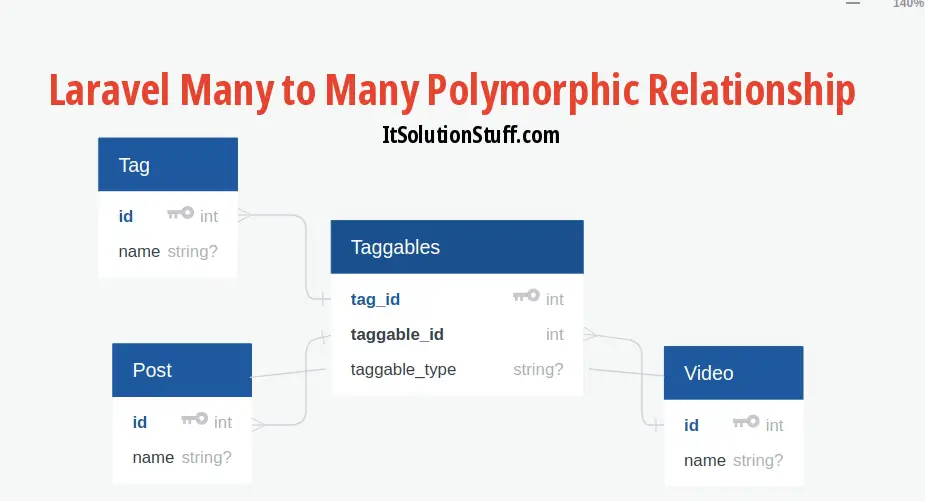Laravel Many to Many Polymorphic Relationship Tutorial
Many to many Polymorphic relationship is also a little bit complicated to understand. For example, if you have posts, videos, and tag tables, you require to connect with each other with your requirement like every post have multiple tags and same for videos too. Also every tag many are connected with multiple post or multiple videos too. But we can easily do it using just one table "taggables". Just read the article and you got it.
many to many polymorphic relationship in laravel 6, laravel 7, laravel 8, laravel 9, laravel 10 and laravel 11 application.
In this article, you can understand how to create polymorphic many-to-many relationships with migration with a foreign key schema for one to many relationships, use sync with a pivot table, create records, attach records, get all records, delete, update, where condition and everything related to many to many polymorphic relationship.
In this example, i will create "posts", "videos", "tags" and "taggables" tables. each table is connected with each other. now we will create many to many polymorphic relationships with each other by using laravel Eloquent Model. We will first create database migration, then model, retrieve records and then how to create records too. So you can also see database table structure on below screen.

Polymorphic Many to Many Relationship will use "morphToMany()" and "morphedByMany()" for relation.
Create Migrations:
Now we have to create migration of "posts", "videos", "tags" and "taggables" table. so let's create like as below:
posts table migration:
Schema::create('posts', function (Blueprint $table) {
$table->id();
$table->string("name");
$table->timestamps();
});
videos table migration:
Schema::create('videos', function (Blueprint $table) {
$table->id();
$table->string("name");
$table->timestamps();
});
tags table migration:
Schema::create('tags', function (Blueprint $table) {
$table->id();
$table->string("name");
$table->timestamps();
});
taggables table migration:
Schema::create('taggables', function (Blueprint $table) {
$table->id();
$table->integer("taggable_id");
$table->string("taggable_type");
});
Create Models:
Here, we will create Post, Video and Tag table model. we will also use "morphToMany()" and "morphedByMany()" for relationship of both model.
Post Model:
<?php
namespace App\Models;
use Illuminate\Database\Eloquent\Model;
class Post extends Model
{
/**
* Get all of the tags for the post.
*/
public function tags()
{
return $this->morphToMany(Tag::class, 'taggable');
}
}
Video Model:
<?php
namespace App\Models;
use Illuminate\Database\Eloquent\Model;
class Video extends Model
{
/**
* Get all of the tags for the post.
*/
public function tags()
{
return $this->morphToMany(Tag::class, 'taggable');
}
}
Tag Model:
<?php
namespace App\Models;
use Illuminate\Database\Eloquent\Model;
class Tag extends Model
{
/**
* Get all of the posts that are assigned this tag.
*/
public function posts()
{
return $this->morphedByMany(Post::class, 'taggable');
}
/**
* Get all of the videos that are assigned this tag.
*/
public function videos()
{
return $this->morphedByMany(Video::class, 'taggable');
}
}
Retrieve Records:
$post = Post::find(1);
dd($post->tags);
$video = Video::find(1);
dd($video->tags);
$tag = Tag::find(1);
dd($tag->posts);
$tag = Tag::find(1);
dd($tag->videos);
Create Records:
$post = Post::find(1);
$tag = new Tag;
$tag->name = "ItSolutionStuff.com";
$post->tags()->save($tag);
$video = Video::find(1);
$tag = new Tag;
$tag->name = "ItSolutionStuff.com";
$video->tags()->save($tag);
$post = Post::find(1);
$tag1 = new Tag;
$tag1->name = "ItSolutionStuff.com";
$tag2 = new Tag;
$tag2->name = "ItSolutionStuff.com 2";
$post->tags()->saveMany([$tag1, $tag2]);
$video = Video::find(1);
$tag1 = new Tag;
$tag1->name = "ItSolutionStuff.com";
$tag2 = new Tag;
$tag2->name = "ItSolutionStuff.com 2";
$video->tags()->saveMany([$tag1, $tag2]);
$post = Post::find(1);
$tag1 = Tag::find(3);
$tag2 = Tag::find(4);
$post->tags()->attach([$tag1->id, $tag2->id]);
$video = Video::find(1);
$tag1 = Tag::find(3);
$tag2 = Tag::find(4);
$video->tags()->attach([$tag1->id, $tag2->id]);
$post = Post::find(1);
$tag1 = Tag::find(3);
$tag2 = Tag::find(4);
$post->tags()->sync([$tag1->id, $tag2->id]);
$video = Video::find(1);
$tag1 = Tag::find(3);
$tag2 = Tag::find(4);
$video->tags()->sync([$tag1->id, $tag2->id]);
I hope you understand of many to many relationship...
*** Click On it and Read in Details of RelationShip types:

